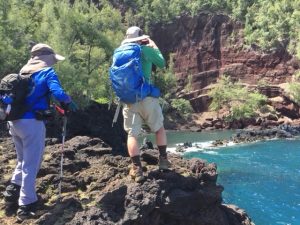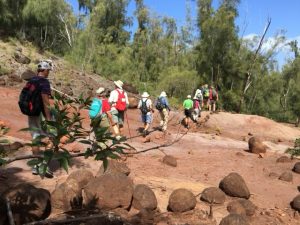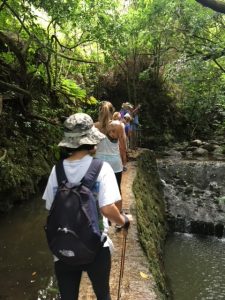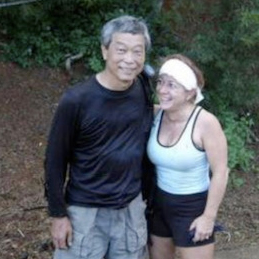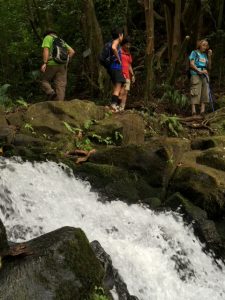Lessons Learned: Along the Trail with Mel Yoshioka
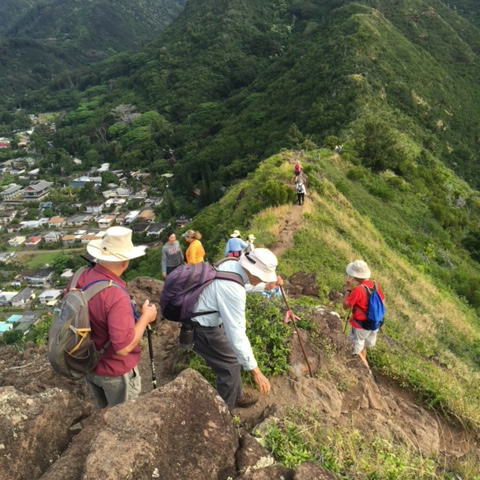
As we know, the benefits of hiking are unlimited; Exercise, fresh air, discovering new places, bonding with fellow hikers, and awareness of our environment. Occasionally there are unexpected and undesirable experiences along the trail. I would like to share a few incidents when I was helping lead hikes that became valuable learning experiences.
Mel Yoshioka, June 2022
Incident 1: Lulumahu Hike – Heart Attack!
Prior to leading a hike, I try to screen individuals for proper equipment, such footwear, water and recent hiking experience.
On this hike I notice an individual to be grossly overweight. I asked him about his hiking experiences which were on the mainland. I was impressed when he told me he did the Appalachian Trail. I felt, anyone who could do the Appalachian Trail can definitely hike Lulumahu falls. I did not ask him how many attempts it took to complete the Appalachian Trail. Most people complete it after four attempts.
He was allowed to hike.
As we were having lunch at the Falls, the sweep contacted me via radio to say they won’t be able to reach us as this individual needed to rest. She requested they be picked up on our return trip. Which we did.
About 20 minutes before the end of the hike, this individual requested to rest. We stopped at a slight ditch which supported his back. After resting about 8 minutes, he indicated he was ready to go. As he started to stand, he began to stumble as I caught him with my knee. I taped his back while saying “are you OK, are you OK”
There was no response. There was no pulse also. I asked three people with cell phones to call 911. They could not make contact. They went to a Clearing and one of them was able to contact 911.
It took the rescue people about 45 minutes to arrive as they could not find our location in the forest. Several people were sent to the trailhead to guide them in. In the meantime CPR was continued.
When the rescue people arrived they tried to revive him by using a defibrillator, injecting fluid intravenously and inserting a tube down his throat to his stomach. None of it worked.
The color of his skin changed and it was fairly obvious he died, however the rescue people would not confirm or deny his status. An MD would need to make the call.
The next day, while talking on my ham radio with a friend, a doctor from Straub, who was monitoring, broke in and reassured me that we did everything possible. He mentioned the individual had a heart attack. Even if he collapses in the lobby of the hospital, we wouldn’t be able to save him.
His comments brought a big relief as I constantly wondered if there was anything else I could have done.
Lessons Learned:
–First Aid certification
–Bring a smartphone and check for cell service during hike
–Any communication in the forest is not as efficient as open field
–Bring walkie-talkie, if possible.
–Screen Hikers
Incident 2: Mauna Loa: Hypothermia and Sleeping on A’A Lava
This mountain can be deceiving because of its gradual grade. The climb is not technically difficult but it’s long and hot. The heat comes up from the black lava while the sun beats on you from the top. You’re caught in between. It can also be very cold at night.
Our hike started from the bird park which is about 6000 feet in elevation. Our destination was the Red Hill cabin at 10,000 feet. We knew there was no water at the cabin so we carried an additional 5 gallons of water among us. What we did not realize was the weight of the water slowed us down considerably along with the thin air and cold.
We hiked in a slight mist for several hours not knowing we were becoming wet as the mist was so slight that it was not noticeable except for your glasses.
We hiked until about 9 PM going from one ahu to another until our batteries ran out. A short while later one of our members was concerned she was slowing the group down and would stay out waiting until we picked her up on our way back.
I told her no way we would do that. We hike as a group. If anyone stops, we all stop. I noticed she was shivering, tired with slurred speech.
I asked her to change into dry clothes as it was wet from the mist and sweat. After she changed, I experienced a miracle! Within 15 minutes she was like a new person, encouraging us to “let’s go!”
Although unknown at that time, these are signs of hypothermia or altitude sickness.
That night we were all exhausted and looking forward to a good night’s sleep. The only place to sleep was in the lava field. We looked for the smooth pahoehoe but could not find any in the dark. Our only choice was sleeping on A’a lava.
I remember seeing some Indian people sleeping on a bed of nails and thought that was amazing. After sleeping on A’a lava…sleeping on nails looked easy as all the nails were the same height. A’a is jagged.
Fortunately we all had sleeping bags. We found comfortable positions and were able to sleep in the lava. When I awoke, I saw three mounds that looked like white mummies. The bags were covered with frost overnight. The sleeping bag is designed to pull moisture from the inside to the surface. The frost was easily dusted off as it was dry.
In the morning, to our surprise we saw the cabin only about a 20 minute hike away. Although we had an altimeter, the location of the cabin was only an estimate. If it was daylight, we would have seen the cabin.
It was an adventure with unexpected challenges. Fortunately it all ended well.
Lessons Learned:
–Plan for a much longer hike when carrying an additional 5 gallons of water.
–be aware of altitude sickness
–carry a space blanket
–Avoid hiking at night
–Bring dehydrated emergency food such as mug of noodles, coffee, fruits and a portable store
Incident 3: Kawainui – Cliff Hanger
This hike is unique in that it has 12 stream crossings and the largest freshwater swimming hole on Oahu.
The day began uneventfully until halfway into the hike when a female hiker began complaining about mosquitoes as we hiked through a damp shaded area with thick hau bush growth.
I assured her that once we were out of the woods and in a sunny area, the mosquitoes would not be a problem. Nevertheless she continued to hike in a half-hearted manner, not giving full attention to the trail.
Suddenly she stumbled. I tried to grab her backpack, which slipped out of my hand. A small ohia tree momentarily broke her fall, allowing me to grab one of her arms.
While dangling over the cliff she was struggling and crying, “I don’t want to die–I don’t want to die,” and my grip on her arm was sliding as my hand was wet with sweat.
In the meantime the other hikers were sitting on the dam waiting for us to catch up. Witnessing the situation, several hikers came running to our rescue. They made a human chain and lifted the hiker from the cliff.
Their rescue was timely as I was about to fall over the cliff with the hiker. My one leg was lying sideways on the trail with the inner portion of that leg trying to press down on the trail to maintain grip through friction.
The fall would have been onto a dry stream bed with exposed rocks, about 40 feet below.
Thanks to the rescuers, they were able to stabilize the situation and pull the hiker to safety.
Two of the rescuers were HTMCers Janice Nako and Don Piburn.
Lessons Learned:
–Many situations can happen on a hike. Some may be anticipated, others are emergencies, others just “pop up.” In this situation the leaders did the right thing. The sweep kept close watch on the unhappy hiker. The hiker leader waited for everyone to catch up.
Incident 4: Aiea Ridge Trail
This trial may not be the longest but is very exhausting because of its constant up and down.
We were about an hour from the top when a female hiker slipped and fractured her left arm. Fortunately someone had a magazine in his backpack and I was wearing a bandana on my forehead. The magazine was used as a splint. The bandana was used as a sling to support her arm against her body. A walking stick was cut to help with her balance while walking.
The injured person, with the help of the sweep, was able to reach the trailhead until the group caught up with them on their return.
Lessons Learned:
–Occasionally, on the trail, unforeseen and undesirable events happen. In most emergencies special equipment would not be available. This situation was no different. First Aid training is all you have. It would awaken your knowledge as to what to do.
Incident 5: Olomana: two HTMC hikers fell, I was one of them.
It started as a trail clearing project. There were about 12 of us strung along the ridge trail.
As I was descending the second peak, rocks crumbled beneath my feet causing me to lose balance and fall 150 feet on the Maunawili side of the trail. Fortunately my backpack prevented me from sustaining spinal injuries as I tumbled head-over-heel. A tree between my legs prevented me from falling another 200 feet.
It is amazing how certain things rush through my mind during the several seconds of the fall.
I recall trying to apply the self-arrest (stopping) technique I learned on the slopes of Mount Rainier, in preparation for the summit climb. It didn’t work. Those lessons were useful for any fall except when falling head over heel. Ice ax or boot pick was useless to gain traction. I distinctly remember yelling Oh S–t.
Meanwhile, Jackie and her husband Dayle Turner were claiming the third peak. Dayle noticed several tree tops shaking as when boulders get dislodged, then he heard my yell. He told Jackie, it’s one of us. Jackie, being an emergency room nurse, wanted to help.
Dayle warned her to be extra careful as the third peak can be very dangerous.As she proceeded she slipped and fell about 150 feet. Luckily a Christmas berry tree broke her fall.
Jackie sustained a laceration on her forehead and I had three broken ribs. Dayle later indicated I dislodged a boulder and a tree during my fall.
I was asked if 911 should be called as I was not in a condition to climb back up the second peak, as well as lower myself down the first peak. I suggested that 911 not be called, as I knew TV personnel and reporters will be waiting to cover the story. I anticipated a possible headline saying “Two HTMC hikers fall from Mount Olomana.”
A group decision was made to walk Jackie and me out from between the second and third peak. We were secured with ropes and guided by others walking near us.
“Mama” Mable Kekuna was waiting for us as we emerged from the forest. She gathered us together to emphasize hiking safety. Her message was meaningful especially to the trail clearing group. She reminded us that we will experience a serious injury at least once in our lifetime based on the frequency of our exposure and equipment used. I’m sure many of us can relate to close calls.
We were taken to Castle hospital by Mable and Darryl Teruya. Jackie had several stitches on her forehead. Not much could be done to my rib injuries except have time to heal. Sneezing, coughing, laughing and yelling definitely reminded me of a rib injury.
Lessons Learned:
–As on any trail we must be careful, especially Olomana. More lives have been lost on this trail than any other trail in Hawaii. Subsequent to my fall, there were four deaths.
–Olomana is one of the most dangerous trails on Oahu, along with Pu’u Manamana.
–Avoid climbing it when wet. Hard rubber sole boots lose their traction when wet or muddy.
–Cleats help. Be secure of your footing and handholds. Rope is helpful when dry, but can be slippery when wet. Cell phones should be a required hiking equipment on all hikes. Just be aware it’s range can be limited in the mountains. In summary, we both were extremely lucky to walk away with relatively minor injuries. I am convinced the Lord was watching over us.
Incident 6: Mt. Ka’ala
Earlier during the day we summited the highest mountain on Oahu, Mt. Ka’ala, from the Waialua direction.
The main attraction was the bog with its many rare plants and unusual terrain. All the plants are stunted as there are minimum nutrients except from decaying plant life and the highly acidic water.
On the return trip, Dr. Cedric Yoshimoto led the group and I was the sweep. About an hour after we began our descent, an urgent message was relayed to me. A hiker had fallen off of the trail. As I ran down the narrow trail to help, I also almost ran off the trail, but was able to swing around a small tree which brought me back on track.
We were hiking single file and a female hiker just happened to look over her left shoulder and catch a glimpse of another hiker falling over the side, bouncing off the mountain and landing on a small ledge.
When I reached the trail above where the hiker had fallen, I noticed an electric cable wrapped in a plastic cover, hanging. I used that cable to get to the fallen hiker. Initially I failed to consider the cable and my hands were wet. I began slipping as I descended. Fortunately, I was able to stop and did a body wrap with the cable to slow me down to the fallen hiker. He was laying on a small ledge.
A slight move could mean another 100 foot fall.
Upon reaching the hiker, I started asking him questions about his age, date of birth, place of birth and high school name. Satisfied, I began pinching his toes and fingers to determine if he had any spinal injuries. He was ok. After several minutes, he was able to sit up.
For some unknown reason, that day, I had carried a nylon webbing in my backpack, which normally I don’t. I tied a chest harness clipped with a carabiner to support his climb back to the trail along with two hikers at his sides.
At the top, Dr. Yoshimoto did an exam and found no major problem.
I tried calling 911 on my ham radio but was unable to reach the state repeater system as my signal was blocked by the mountains. This system has repeaters on the highest peaks of four major islands and covers all islands.
Fortunately, someone was monitoring the Kauai repeater and heard my request for help. It’s almost impossible to contact Kauai directly with a tiny handheld ham radio, except we were on the north-westerly side of the island, facing Kauai and transmitting over water improves propagation.
Kauai called Oahu 911 and a helicopter was dispatched. Because of the strong winds and tree cover the helicopter was unable to land. The injured person was carefully moved to a better landing spot.
A basket was lowered to the injured person along with emergency personnel. They both were lifted, dangling from the helicopter to a waiting ambulance at Waialua high school.
As in most emergency situations, it’s difficult to have the right equipment. In this case, I was fortunate that I had a nylon webbing and a handheld ham radio, activated Kauai repeater, and that someone had a glimpse of the hiker falling, that there was a cable near the fall and an emergency helicopter.
Lessons Learned:
–In other unexpected situations, experience and first aid training are the key.
Summary of Lessons Learned from Six Incidents Above: Be prepared because anything can happen on the trail!
Incident #1: Knowledge of CPR
Incident #2: Extra clothing, A’a lava, sleeping bag, hypothermia
Incident #3: Have a designated sweep
Incident #4: Bandana and magazine
Incident #5: Avoid dangerous trails when wet
Incident #6: Bring your cell phone- but know it’s limitations
Extra: My Sickle and Trail Clearing
We were returning to our cars after clearing the trails for several hours. That day I was using a razor sharp sickle Which I usually secure with a protective covering and place it in my backpack when my work is done. That day I wanted to touch up some areas we missed on my way out.
I knew that it was dangerous to hike back with an exposed sickle at a faster pace on a slippery trail, but my thoughts were to dispose of the sickle before I fell.
Well, I fell with my knee landing directly on the blade. I was so very lucky the blade just happened to be lying flat on the trail. Till this day I shutter what could have happened if the blade had been facing upward when I fell on it.
Hiking is literally an adventure that I’m happy to share. I consider myself lucky to have gone through it and would like to remind people to be aware of its many hazards.
The End,
Mel


